Abstract
Sample storage is a key factor in odour quantification. This study investigates the loss of odorous compounds in Nalophan™ sampling bags during storage, simulating real-world transport and storage conditions. The goal was to quantify compound leakage over time by varying operational parameters to identify the most significant losses. The tested compounds—sulphur, oxygenated, and hydrocarbon VOCs—were prepared in the laboratory at 10 ppm. Tests were conducted on 12 L Nalophan™ bags with sampling intervals of 0, 6, 30, 48, and 100 h, exceeding the EN 13725 guideline limits (30 h). To evaluate recovery, environmental and internal humidity and temperature were varied. Additionally, the adsorption surface was increased by inserting Nalophan™ flakes inside the bags. The results show that under ambient conditions, losses during 30 h are contained and are within the order of instrumental uncertainty for all the tested compounds. A higher ambient temperature and humidity did not significantly affect recovery. In contrast, internal humidity appeared to have a more noticeable effect, particularly affecting low molecular weight sulphur compounds and oxygenates. These findings suggest optimal storage strategies for olfactometric samples, highlighting that significant losses do not occur within the EN 13725:2022 storage time limits. Moreover, even exceeding these time limits, the observed losses remain limited to 100 h.
1. Introduction
Odour assessment and management represent critical aspects of environmental monitoring and air quality control [1,2,3]. Moreover, in recent years, attention to the impact of industrial odours has increased, and with the latest revision of the European Industrial Emission Directive (IED 2), the definition of “pollution” now includes the release of an “odour” from industrial facilities [4].
Within this context, dynamic olfactometry, standardised by the European Standard EN 13725:2022, is the principal technique for determining odour concentration (Cod) through sensorial evaluation [5,6]. The practical implementation of dynamic olfactometry involves the collection of odorous samples directly at emission sources using sampling bags, followed by transportation to a laboratory for subsequent analysis [5].
This process necessarily introduces a temporal delay between sample collection and olfactometric measurement, often conducted far away from the sampling site. During this interval, the integrity of the sample may be compromised. Due to the increasing interest in quantifying odorous emissions and the need to consider odour impact within the permitting processes for different categories of industrial facilities, as in the case of other pollutants, the stability of the sample during its storage and transport represents a fundamental concern for accurate odour assessment and constitutes a possible source of uncertainty in olfactometric measurements [7,8,9].
During the transport and storage of odorous samples, three principal alteration phenomena can occur: adsorption, diffusion and chemical transformation of odorants [5].
Focusing on adsorption and diffusion, in the literature, many studies pointed out their importance during the storage and transport of sampling bags [10,11,12,13,14,15,16,17].
These phenomena can potentially lead to a substantial underestimation of odour concentration, with consequent implications for odour concentration measurements [18]. Understanding and quantifying these processes and identifying the most influential parameters are therefore critical for ensuring the reliability of olfactometric measurements.
Multiple factors influence the stability of odorous compounds in sampling bags [13,14,19,20,21,22,23].
The material composition of the bag plays a pivotal role. The European standard EN 13725 and the German standard VDI 3880:2011 define requirements for sampling materials, emphasising inertness, smooth surface, odour neutrality, low permeability, and mechanical resistance [5,24]. In particular, the technical standards suggest the use of sampling materials such as Tedlar® (polyvinyl fluoride, PVF), Nalophan™ (polyethylene terephthalate, PET), or Teflon™ (polytetrafluoroethylene, PTFE). However, in the literature, it is well known that these materials potentially exhibit different gas permeability characteristics and adsorption properties [16,25,26,27], which influence the stability of odorants inside sampling bags.
Storage time represents another critical factor. According to EN 13725, the sample needs to be analysed as soon as possible, and the maximum storage allowed by the standard is equal to 30 h, in order to minimise sample degradation. On the contrary, even more stringently, the VDI 3880 states that an odour sample can be stored only for up to 6 h after collection to avoid alterations in the sample that could compromise the results.
The specific chemical properties of odorous compounds may influence their stability in sampling bags. Differential losses have been documented for various classes of odorous compounds, including reduced sulphur compounds, carboxylic acids, phenols, indoles, and volatile organic compounds (VOCs) [28,29,30]. In the literature, these losses are correlated with physicochemical properties such as polarity, molecular weight, and molecular size. Notable examples include rapid losses of ammonia (NH3), hydrogen sulphide (H2S), and volatile fatty acids (VFAs) in polymeric bags [7,31]. On the contrary, hydrocarbon compounds were found as the most stable compounds during the storage of olfactometric bags [28,32,33].
Storage conditions, including temperature and relative humidity, further modulate sample stability by influencing adsorption kinetics and chemical reaction rates [15,34]. Additional factors affecting gaseous sample integrity include the degree of sample dilution, the presence of particulate matter, the surface-to-volume ratio of the bag, and the number of valves incorporated into the bag design [8,17,35,36,37].
To enhance comprehension of the potential losses from sampling bags during the storage of odorous substances, several studies have been conducted to investigate the decay and the loss of specific odorous compounds in various bag materials. Different studies [15,17,21,25,28,30,36] have compared the performance of various bag materials, examining mechanisms of loss including adsorption, diffusion, and chemical reactions. Among the materials tested in the literature, Tedlar® bags have been the traditional standard in the United States, though they exhibit compound losses and background contamination issues [28,30]. NalophanTM bags are widely adopted in Europe due to their standardisation and cost-effectiveness, despite known limitations including significant losses of certain compounds and limited storage time (typically <12 h for acceptable recovery) [15,25,30]. Recent studies indicate that FEP and PTFE materials offer superior performance with better compound recovery and stability [17,36]. However, a review of the extant scientific literature reveals that the existing research exhibits limitations, particularly related to the storage conditions tested, which were often extreme compared to the actual storage conditions of olfactometric samples. In addition, the relative contributions of the two complementary and competitive phenomena (i.e., diffusion and adsorption) remain to be elucidated.
Therefore, a significant number of issues remain to be addressed and explored to enhance our understanding of the phenomenon of leakage of odorous mixtures during the storage and transport of polymeric bags.
For these reasons, the present study aims to quantify the losses of odorous compounds in NalophanTM bags commonly used in olfactometric sampling and to analyse the loss phenomena as a function of storage time and conditions. The investigation focuses on compounds particularly present within industrial odorous emissions and relevant in terms of odorous potential, focusing on sulphur and oxygenated compounds. In particular, the main goal of this study is to observe the influence of diffusion and adsorption phenomena on the stability of odour compounds by identifying the operating parameters that most affect losses.
In addition, diffusion and adsorption phenomena will be investigated to evaluate both phenomena.
The findings of this study may provide significant practical information for olfactometry practitioners to understand the storage parameters and leakage phenomena that are most significant for sampling bag losses.
2. Materials and Methods
2.1. Sampling Bags Preparation—Standard Conditions
NalophanTM sampling bags were used to conduct the leakage tests of this study. The bags were obtained from a tubular film with 20 µm thickness and 30 cm length (Tilmmanns S.p.A, Milan, Italy). In this study, bags with a volume of 12 L were produced. To obtain this volume, the NalophanTM tubular (width 31.4 cm) was cut to a length of 72 cm, with one end closed using a clamp closure, while the other end was fitted with a TeflonTM inlet tube for sample collection and measurement. The created bags were then tested with different odorous gas mixtures generated in laboratory tests according to specific sampling times (0, 6, 30, 48, and 100 h). The tests at 6 and 30 h were selected according to the VDI 3880 and EN 13725 restrictions, respectively.
Samples for stability tests were prepared in two different methods, according to the availability of the odorant substances:
- –
- Dynamic generation of the mixture using a syringe pump.
- –
- Certified cylinders at a known concentration.
For all the tests described below, compound concentrations on the order of 10 ppm were considered. This concentration was chosen to be as comparable as possible with the concentrations of the chemical compounds present in an odour mixture and readable by the instruments used in the experiments. Furthermore, compounds belonging to three different chemical families, frequently observed in odour samples, were selected for analysis: hydrocarbons, oxygenated and sulphur.
Dynamic generation was applied to compounds with a vapour pressure exceeding 0.1 kPa at 20 °C. In particular, through dynamic generation, the following compounds were produced: n-Hexane, methyl ethyl ketone (MEK), valeraldehyde, propyl mercaptan, butyl mercaptan, and dimethyl disulphide (DMDS). All the liquids were supplied by Sigma-Aldrich® (Saint Louis, MO, USA) with a purity higher than 95%.
A syringe pump (NE-300 Just Infusion™, KF Technology, Roma, Italy) delivered continuous injection of the volatile liquid via a 10 μL glass syringe (Hamilton Microliter #701, Hamilton, Reno, NV, USA) into a neutral air stream, as previously described [38,39]. The resulting enriched gas was collected directly into a 90 L NalophanTM bag at the system outlet.
For compounds not available as pure liquids, certified gas cylinders were used to obtain samples at known concentrations. In particular, certified cylinders were used for the generation of the mixture of hydrogen sulphide and methanethiol (supplied by Sapio Group, Caponago, Italy).
For both methods, once collected in the 90 L NalophanTM bag, the gaseous mixtures were then transferred into individual 12 L bags and subsequently analysed. A large-volume transfer bag was necessary to ensure a homogeneous starting mixture, guaranteeing consistency across all the subsequently filled 12 L bags.
2.2. Sampling Bags Preparation—Wet Conditions
To investigate the case of a wet sample and to better simulate a real sampling scenario, tests with humidified odorous mixtures were conducted. In this study, a relative humidity (RH) of 75% was selected to represent a moderately high humidity level, referring to the dry sample condition. The methodology for preparing humid gaseous samples (at 20 °C and relative internal humidity of 75%) is described below.
For humidification via the syringe-pump system, diluted air was passed through a water bubbler, generating moisture-enriched air. For certified cylinder H2S humidification, a dual-branch system was employed. The first branch delivered H2S at 10 SL/h via a mass flow controller (Alicat™ MB Serie Meters, Tucson, AZ, USA). The second branch routed technical air (290 SL/h) through a water bubbler, enriching itself with water molecules and thus becoming humidified.
In both experimental setups, a thermo-hygrometer (Testo S.p.A., Settimo Milanese, Italy) was used to monitor temperature and relative humidity parameters in the sample flow.
2.3. Influence of Environmental Storage Conditions
After the preparation of the sampling bags, these were stored under different storage conditions to investigate the influence of environmental parameters on losses. It should be noted that sample storage must adhere to specific requirements outlined in relevant standards. The 2003 version of EN 13725 specified a maximum storage temperature of 25 °C [40], a requirement which was removed in the current EN 13725:2022 revision. However, the VDI 3880 still maintains a temperature threshold of 25 °C, specifically stating that “temperature is to be above the dew point to prevent condensation in the bag”.
Our storage conditions were deliberately selected to both align with these standardised parameters and simulate realistic conditions encountered during actual monitoring campaigns:
- –
- Ambient condition (T = 20 °C and RH = 55%).
- –
- Warm environment (T = 35 °C and RH = 20%).
- –
- Wet environment (T = 20 °C and RH = 80%).
To investigate the leakage phenomena under ambient conditions (T = 20 °C and RH = 55%), bags were stored under a lab extractor hood, where the temperature and humidity closely resembled the surrounding environment (about 20 °C in temperature and 55% in relative humidity, registered by using a datalogger).
For the evaluation of bag leakage under stressed system conditions (a high temperature or high environmental humidity), the bags were stored inside an oven (BD 240, BINDER GmbH, Tuttlingen, Germany) or a climatic chamber (Chamber GHUMY, Fratelli Galli, Milan, Italy) until the analysis. The oven was used for high-temperature testing (T = 35 °C to simulate summer transportation), while the climate chamber was employed for experiments in humid environments (T = 20 °C as the environmental temperature and RH = 80%). It is important to note that all storage areas for the bags were monitored using a data logger to track temperature and humidity values.
2.4. Estimation of Adsorption
The last investigation was the evaluation of the contribution of the adsorption phenomenon to gaseous losses in sampling bags. To conduct this test, it was necessary to increase the available adsorption surface. Therefore, Nalophan™ flakes were introduced into the bags to increase the total internal surface area. The total surface area of the flakes, considering both sides of each flake, was approximately five times greater than the internal surface of the empty bag, as reported in Figure 1.
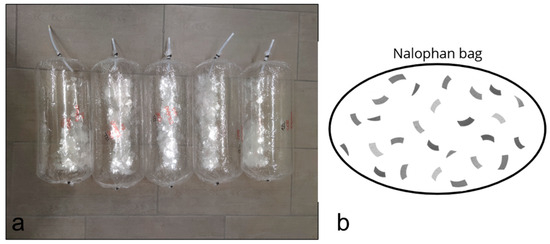
Figure 1.
The adsorption test: (a) NalophanTM bags filled with flakes; (b) a schematization of the adsorption test.
These bags were stored in ambient conditions (T = 20 °C and RH = 55%) to compare the diffusion and adsorption phenomena.
2.5. Sample Bag Analytical Procedure
Expeditive instruments were used to quickly detect the concentration of compounds present in the bags and to study the leakage phenomena from sampling bags. In particular, the instruments below were used in this study:
- –
- A Flame Ionisation Detector (FID) was used to quantify the concentration of volatile organic compounds, VOCs. Based on the ionisation of compounds in a hydrogen flame, it offers high sensitivity and a wide dynamic range.
- –
- An electrochemical sensor was used for the specific detection of H2S.
These instruments supply rapid information regarding the concentration of compounds, without discriminating between different compounds. Therefore, they are an effective tool when the compound to be quantified is uniquely known in advance and a rapid response is required, as in the case of this study.
To enhance the representativeness of the measurement with respect to the sample and to ensure greater consistency, a triplicate measurement procedure was implemented.
Regarding the analysis of VOCs, an FID RS 55-T (Ratfish Analysensysteme GmbH, Poing, Germany) was used. The declared uncertainty of measurement of the instrument was 4%.
For hydrogen sulphide, an electrochemical sensor (Optima 7 Biogas, MRU, Thiene, Italy) specific for the quantification of H2S was used. According to manufacturer specifications, the instrument exhibited a measurement uncertainty of 5% relative to the measured value within the operational range of 0–500 ppm.
3. Results
The graphs below report the relative recovery, obtained as the measured concentration normalised for the initial one, for all the compounds analysed. The graphs are divided according to compounds’ families (hydrocarbons, oxygenated and sulphur) and according to the type of considered test.
As previously reported, triplicate measurements were performed to enhance the representativeness of the measurements and achieve enhanced consistency. The graphs below report the average value of the three measurements for each analysed bag at the corresponding time.
In addition, the respective error bars for the instrument used are also reported for each measure, representing instrumental uncertainty (4% for FID for VOCs and 5% for the electrochemical sensor for H2S).
3.1. Ambient Condition
Figure 2 reports the observed trend for the three families considered at 20 °C and RH = 55% (ambient condition).
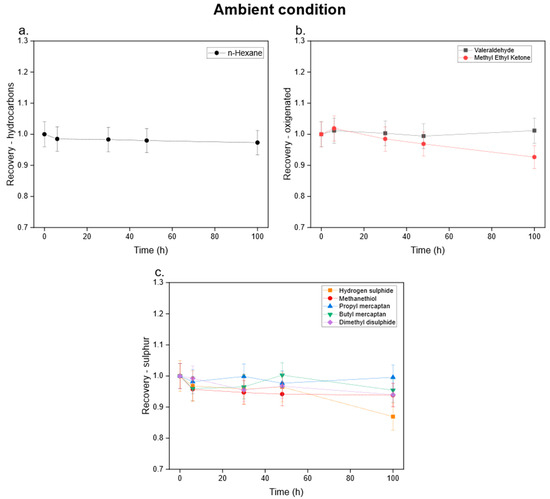
Figure 2.
Recovery test—ambient conditions for hydrocarbon (a), oxygenated (b), and sulphur compounds (c).
Analysis of the observed recovery trends (Table S1) shows that percentage losses, calculated relative to initial concentrations, appear generally limited and comparable to the instrumental uncertainty.
Within the maximum time constraints specified by the EN 13725:2022 and VDI 3880:2011 standards for olfactometric analyses (30 h and 6 h, respectively), the losses remain comparable with instrumental uncertainty and, in any case, extremely limited. This observed variation appears to be acceptable, specifically considering the uncertainty associated with subsequent dynamic olfactometric analysis. Therefore, based on the leakage observed during experimental trials, the concentration variations can be considered negligible compared to olfactometric measurement resolution (factor 2).
Comparative analysis of the performance of different families confirms that hydrocarbons constitute the most stable compound class, with losses detected at 100 h comparable to values of instrumental uncertainty (4%). This finding is corroborated by the previous literature, which identifies hydrocarbons as the most stable class of molecules [28,32].
Whilst sulphur compounds, particularly hydrogen sulphide, demonstrate marginally higher losses compared to other compound families, it is noteworthy that these losses remain within acceptable parameters—less than or approximating instrumental uncertainty—even after extended storage durations of 100 h under ambient conditions. Importantly, within timeframes relevant to standardised olfactometric analyses (≤30 h), the observed concentration variations for sulphur compounds remain minimal and do not compromise analytical integrity. The more pronounced losses observed for sulphur compounds, in particular hydrogen sulphide, become statistically significant only after prolonged storage exceeding four days (100 h of storage), well beyond typical analytical timeframes.
3.2. Effect of Increasing Temperature: Warm Environment
Figure 3 reports the observed trend for the three families considered, stored at 35 °C and RH = 20% (warm environment condition), and Table S2 reports the percentage losses observed during the test.
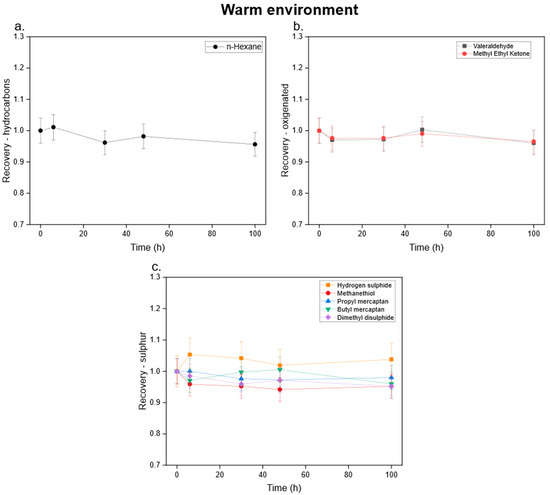
Figure 3.
Recovery test—warm environment (35 °C and RH = 20%) for hydrocarbon (a), oxygenated (b), and sulphur compounds (c).
Experimental results from the elevated temperature environment tests revealed no significant effect of temperature on losses across all compounds examined. Indeed, quantitative analysis demonstrated consistently minimal percentage variations in losses, with values not exceeding 6% within the 100 h of the tests. This maximum loss remains comparable to losses observed under ambient conditions and comparable to instrumental uncertainty, suggesting that temperature may not function as a primary determinant in diffusion processes.
These findings slightly stand in contrast to the previously published literature [14,15,32]. Discussing the trend observed for volatile organic compounds (VOCs), Hsieh et al. (2003) established that reduced temperatures generally promote compound stability compared to higher temperature environments [32]. In addition, focusing on sulphur compounds, Le et al. (2013) demonstrated enhanced losses at elevated temperatures (T = 30 °C) compared to standard conditions (T = 20 °C) for H2S and thiols, in particular butyl mercaptan [14]. However, in the same study, the authors did not observe any variation in recovery by sulphides as the temperature increased [14].
In contrast to previous results, our tests indicate that higher temperatures do not induce losses other than instrumental error for any of the compounds under investigation. As a first, tentative hypothesis to account for the observed discrepancy between the established literature and our current findings, we propose that elevated temperatures might influence the physicochemical behaviour of the gaseous mixture. In particular, higher temperatures could enhance molecular kinetic energy, leading to increased molecular motion that potentially could limit the adsorption on the walls of the sampling bag. While this would appear to counteract temperature-driven diffusion processes that might otherwise promote compound losses, further investigation is needed to finally understand and validate this possible explanation.
3.3. Effect of Environmental Humidity: Wet Environment
Figure 4 revealed that increased environmental moisture (RH = 80%) does not induce significant compound losses. Quantitative assessment (Table S3) showed that observed losses were comparable to those measured under standard ambient conditions (Table S1). As previously established, these percentage losses remain negligible when contextualised against the inherent uncertainty of olfactometric resolution and even chemical instrumental error. The stabilising effect of humid storage conditions observed in this investigation aligns with the limited existing literature. Eusebio et al. (2017) documented enhanced molecular stability for hydrogen sulphide under elevated environmental humidity conditions (RH = 60%), which corresponds directly with our findings, where H2S maintained stability for durations extending to 100 h under wet storage conditions [13]. A plausible mechanistic explanation for this phenomenon involves competitive adsorption processes: environmental moisture may preferentially adsorb onto the sampling bag surface, thereby creating a competitive adsorption dynamic between water molecules and target analytes. This competitive process potentially mitigates both adsorptive and diffusive losses of odorant compounds.
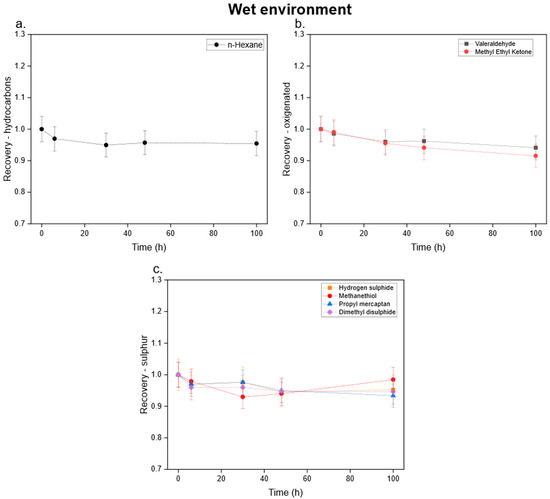
Figure 4.
Stability test—wet environment (20 °C and RH = 80%) for hydrocarbons (a), oxygenated (b), and sulphur compounds (c).
Specifically, the adsorbed water layer may function as a diffusion barrier, impeding the permeation of odorant molecules across the bag material from interior to exterior environments. The scientific literature contains insufficient documentation regarding humidity effects on volatile organic compound (VOC) stability in sampling containers, precluding direct comparative analysis with our experimental results. However, based on our empirical observations, it is possible to hypothesise that VOCs could exhibit analogous behaviour to H2S under these conditions—no detrimental effects from environmental humidity were detected on compound stability or retention.
3.4. Effect of Sample Humidity: Wet Sample
In the context of experiments conducted on wet samples, it is necessary to discuss the NalophanTM permeability to water vapour. Beghi et al. (2008) documented that NalophanTM exhibits significant permeability to water [23]. In particular, relative humidity (RH) within a NalophanTM bag decreased substantially from 80% to 20% during a two-hour interval when maintained at T = 20 °C. Consequently, NalophanTM permeability to water vapour and associated odorant transport phenomena represent critical considerations in sampling methodology and need to be investigated.
Figure 5 reports the observed trend for the three families considered, stored at 20 °C and internal humidity equal to 75% and external one equal to 55% (we sample condition)
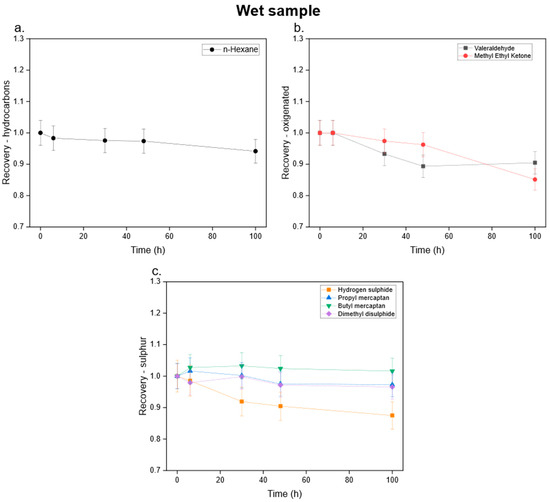
Figure 5.
Recovery test—wet sample (20 °C, RHIN = 75%, and RHOUT = 55%) for hydrocarbons (a), oxygenated (b), and sulphur compounds (c).
Analysis of experimental results regarding VOC leakage from NalophanTM bags under humid storage conditions revealed bifurcated compound trend patterns. The first category comprises compounds that demonstrate stability in the bag irrespective of mixture humidity, including n-hexane, dimethyl disulfide (DMDS), propyl mercaptan, and butyl mercaptan. The second category encompasses compounds that exhibit enhanced losses under humid sample conditions, particularly evident in oxygenated compounds such as valeraldehyde and MEK, but also observed in hydrogen sulphide.
For the second case (valeraldehyde, MEK, and H2S), we propose a potential mechanistic explanation involving weak interactions with the aqueous matrix through hydrogen. It should be emphasised that whilst this mechanism offers a plausible explanation for the observed phenomena, it remains hypothetical. Further dedicated investigations would be necessary to substantiate this hypothesis and develop a comprehensive understanding of the interactions that occur. In this hypothesis, the molecular interaction with water molecules could significantly influence compound losses, as these water-bound complexes may be transported across the sampling bag material. Given that NalophanTM is documented in the literature to be permeable to water [22], the compounds under investigation could be simultaneously lost through this water-mediated transport mechanism, thereby reducing their measured concentrations.
Following this reasoning, these molecular interactions potentially facilitate enhanced permeation through or interaction with NalophanTM structures, resulting in quantifiably greater losses compared to equivalent dry conditions.
The experimental results show relevant losses of H2S in humid samples, with a lowering of concentration values exceeding the analytical uncertainty from 30 h onwards.
Specifically, losses of 8% were detected at 30 h, increasing to 13% at 100 h. Conversely, other sulphur compounds (butyl mercaptan, propyl mercaptan, and DMDS) exhibited enhanced stability under humid conditions, causing reduced losses. The trends obtained in Figure 5 demonstrate that among the analysed compounds, in our test condition, only H2S stability is significantly affected (losses higher than instrumental uncertainty) by mixture humidity under humid storage conditions.
The differential trend of H2S in humid samples can be attributed to its molecular interaction with water coupled with its comparatively lower molecular weight and smaller molecular dimensions. These physicochemical characteristics potentially facilitate enhanced permeation of water-bound H2S molecules toward the external environment. Conversely, the remaining sulphur compounds, characterised by higher molecular weights and larger molecular dimensions, demonstrate limited losses through the material matrix, resulting in superior retention within the sampling container.
To validate these relationships, correlation analysis was performed between molecular weights and solubility of the studied sulphur compounds and their respective losses at 100 h (maximum experimental duration) in the wet sample test.
Firstly, discussing the possible correlation with molecular weight, a graphical representation of the dependence of losses on molecular weight was constructed and analysed (Figure 6). Application of linear regression modelling yielded a robust correlation coefficient, supporting the hypothesis that compounds with a higher molecular weight are better retained. However, it should be noted that, due to the limited number of sulphur compounds available, this result should be interpreted as exploratory.
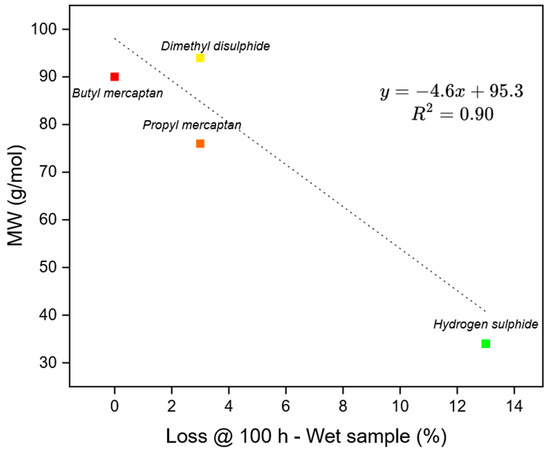
Figure 6.
Correlation between wet sample losses and molecular weight (MW).
Similarly to the increase in molecular weight, it is also observed that the octanol–water partition coefficient (LogP), and thus the increase in hydrophobicity, can stabilise losses and increase recovery, as highlighted in Figure 7.
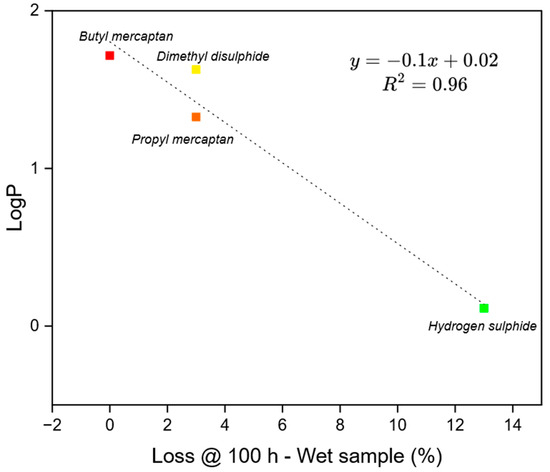
Figure 7.
Correlation between wet sample losses and octanol–water partition coefficient (LogP, from [41]).
As demonstrated in Figure 7, it is evident that the presence of a longer carbon chain, which increases the hydrophobicity of the molecule (i.e., LogP), is associated with a higher recovery. Furthermore, considering compounds’ water solubility values, a graphical representation of the correlation between losses measured at 100 h and the solubility values for the sulphur compounds under this condition is provided (Figure 8).
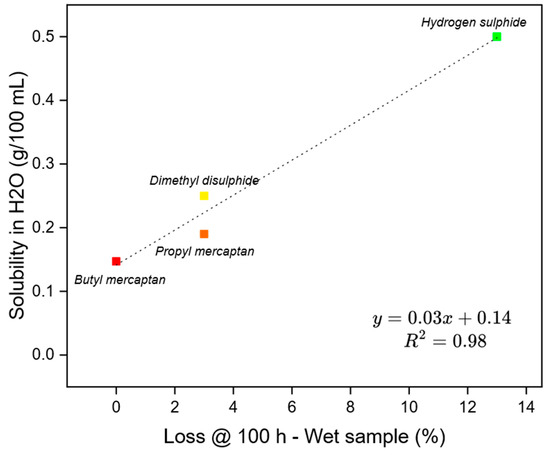
Figure 8.
Correlation between wet sample losses and solubility (from ILO-WHO International Chemical Safety Cards (ICSCs) [42]).
From this comparison, a correlation is observed between compound solubility and compound losses, suggesting that more water-soluble molecules tend to exhibit greater losses compared to less soluble ones.
Regarding oxygenated compounds, their losses trends, previously reported in Figure 5b, are investigated and compared to the information presented in the literature. Hsieh et al. (2003) highlighted that humidity of the sample enhances VOC stability due to the adsorption of water vapour on the inner surface of the bag, thereby reducing VOC loss through NalophanTM [32]. Similar results were reported by other studies [22,37], confirming that the presence of a humid sample does not increase VOC losses. However, Hsieh et al. (2003) [32] also warned of the potential loss of water-soluble compounds upon condensation, emphasising the need to consider the behaviour of these polar soluble compounds. From the reported results, humidity connected with the sample can influence the leakage of polar oxygenated VOCs, leading to higher losses compared to dry conditions. This trend can be explained by the presence of oxygen atoms within the molecule, which may interact with water in the mixture and form the hydrogen bonds, as previously described. This interaction suggests that water permeability through NalophanTM could facilitate the loss of these compounds. Furthermore, it can be hypothesised that molecular reactivity also influences loss rates, potentially explaining why humid valeraldehyde exhibits higher losses compared to humid methyl ethyl ketone, as observed in Figure 5b. By comparing the trend observed for oxygenated VOCs and hydrocarbons (n-Hexane, Figure 5a) it is possible to observe that, while its losses are comparable with the ambient condition test (Figure 2a) and the variation appears in the range of instrumental uncertainty, the oxygenated VOCs present a more significant leakage phenomena, with a loss percentage higher than 10%.
The results from different storage conditions indicate that sample humidity has a slightly greater influence on the recovery of chemical compounds in Nalophan™ bags compared to other storage variables, though this effect varies significantly with the storage duration. At the 6 h timeframe (aligned with VDI 3880:2011 requirements), losses remain minimal for all compounds (≤3%), well within instrumental uncertainty parameters. For samples stored up to 30 h (EN 13725:2022 guidelines), most compounds exhibit limited losses (≤8%), with only hydrogen sulphide approaching this upper threshold. It is only at extended storage periods (48–100 h) that more appreciable losses become evident, particularly for hydrogen sulphide and valeraldehyde. These observations hold practical relevance for sampling of humid odorous sources such as biofilter outlets, scrubbers, or wet biomass. Whilst immediate analysis remains best practice, our findings suggest that samples analysed within standardised timeframes (≤30 h) maintain acceptable compound stability. The results indicate that smaller, water-soluble, and hydrophilic molecules warrant particular attention when longer storage cannot be avoided, though their concentration changes remain modest within recommended analytical windows. On the contrary, an increase in environmental temperature or external humidity does not appear to influence the loss trends of the analysed compounds.
Therefore, it can be hypothesised that diffusion-driven loss increases in the presence of a humid mixture compared to other tested conditions.
3.5. Adsorption Evaluation: Flake Tests
After the evaluation of the influence on recovery of different storage and transport parameters, the investigation specifically took the adsorption into account.
In the literature, this phenomenon is often considered alongside diffusion, but it is not always specifically quantified. In the literature, diffusion is generally considered to be a more significant factor in compound loss than adsorption [16,17]. Few studies have focused on the adsorption phenomenon during the storage of odorant samples, with only a limited number of attempts to quantify its potential contribution. For example, a study by Eusebio et al. (2017) [13] investigated the effect of increasing the available surface area inside the bag, specifically for H2S. This study demonstrated that introducing additional NalophanTM film into the bag resulted in enhanced compound losses. Another study [43] quantified adsorption contribution using a phase ratio variation approach, revealing the extent of adsorption on the inner surface of Nalophan™ polymer bags for a range of volatile compounds and demonstrating the importance of evaluating the sorption effect.
In contrast to the extant literature, which has predominantly focused on individual compounds, such as H2S, and on the effects of increasing the surface area inside the bags, this study provides a comprehensive investigation into the adsorption phenomenon across a broad spectrum of VOCs. The present study focuses specifically on the storage of the samples in polymer bags, thus offering a more holistic approach to understanding how various volatiles are affected during the sampling and storage stages.
To estimate the effect of adsorption on the leakage of odorous compounds, as already mentioned, NalophanTM flakes were introduced into the system (i.e., sampling bags). Using flakes, a significant increase in the area-to-volume ratio was obtained (5 times the internal surface area).
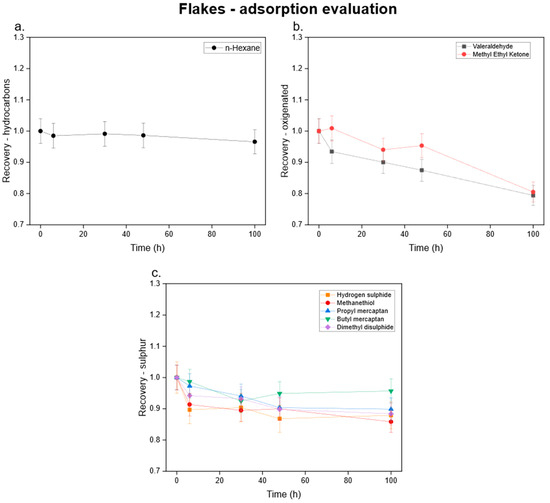
Figure 9.
Recovery test—adsorption estimation with flakes in ambient condition (20 °C and RH = 55%) for hydrocarbons (a), oxygenated (b), and sulphur compounds (c).
The reported results highlight that n-Hexane, representative of the hydrocarbons group (Figure 9a), is not significantly affected by the presence of NalophanTM flakes. This observation can likely be attributed to the absence of reactive heteroatoms in their molecular structure, preventing interaction with the polymeric structure of NalophanTM.
To support this hypothesis, the trend of valeraldehyde and methyl ethyl ketone (MEK), containing oxygen atoms in their structure, was analysed (Figure 9b). Notably, both compounds exhibit greater losses, with valeraldehyde showing an even more pronounced effect.
For sulphur compounds (Figure 9c), the loss trend appears to be influenced, again, by molecular structure and lipophilicity.
Specifically, butyl mercaptan followed by propyl mercaptan exhibits lower losses compared to smaller sulphur compounds. As already discussed for the wet sample test (Figure 7), presenting a longer carbon chain, it is hypothesised that sulphur compounds with this characteristic may have a loss trend in the presence of NalophanTM flakes more related to that of hydrocarbons, thus resulting in a lower effect on the adsorption phenomenon. On the other hand, sulphur compounds with a lower carbon number and molecular weight are more affected by adsorption-stressed loss onto the NalophanTM surface.
From the results obtained, it is possible to preliminarily evaluate that adsorption phenomena are influential in the loss from sampling bags. However, this study was intended as an initial qualitative assessment of the possible role of adsorption phenomena, using a deliberately modified bag surface area to enhance any detectable effects on compound stability. The observed differences suggest a potential influence of adsorption, but further investigation is required to quantify this effect and to understand the mechanisms involved.
4. Conclusions
Through a series of experimental tests conducted on different compound classes and under varying storage conditions, the influence on the stability of the collected bag samples of different conditions parameters, such as temperature, humidity, storage duration, and type of odorants, was evaluated.
Firstly, the obtained results suggest that for all tested compounds under ambient conditions, losses ranged between 0 and 10% within the storage period specified by EN 13725 (30 h) and the VDI 3880 (6 h). This key result highlights that the sampled compounds do not undergo significant losses that could compromise the odour concentration subsequently analysed via dynamic olfactometry within this timeframe. Considering the 100 h threshold, losses increased up to 10% only for specific compounds (H2S), while for the majority of tested VOCs, the concentration remained nearly unchanged over time. This indicates that, even after a prolonged storage period of five days, the stored compounds do not experience substantial variations in concentration concerning the resolution of dynamic olfactometry (factor 2) and instrumental uncertainty.
On the contrary, the obtained results showed that some specific storage factors influence the diffusion and adsorption losses of the collected and transported odorous compounds.
Regarding the type of odorants, this study confirms that hydrocarbons are the most stable compound class under all storage conditions. This stability may be attributed to the absence of heteroatoms, which would otherwise interact with variations in storage parameters as well as with the Nalophan™ material itself.
Discussing the environmental parameters, compounds containing heteroatoms exhibited varying sensitivity to environmental parameters.
In particular, our study indicates that environmental high temperatures (35 °C) do not significantly affect compound stability, resulting in losses limited to a maximum of 6%. These loss values are comparable to those observed under unchanged system conditions. This empirical evidence substantiates the recent revision of EN 13725, which removed the previous 25 °C maximum storage temperature limitation specified in the 2003 version. Our findings demonstrate that temperature does not influence odorant recovery, recognising that time-dependent losses are more significant than temperature-dependent effects within the operational parameters relevant to olfactometric analysis. The standard’s elimination in the 2022 version of the reference to a strict temperature threshold better reflects the actual stability characteristics of odorous compounds in Nalophan™ sampling bags, whilst affording greater logistical flexibility during field monitoring campaigns. Similarly, high environmental humidity (RH = 80%, T = 20 °C) contributes to maintaining compound stability. Indeed, our results indicate that losses remain below 10%, and it was also hypothesised that competitive adsorption of water on the bag surface limits sample losses.
On the contrary, regarding the sample humidity, in this study, more significant losses were observed under humid conditions, particularly for polar compounds containing heteroatoms. These compounds, which can potentially interact more readily with water, permeate more easily through the bag, given that Nalophan™ is the most water-permeable material among those specified in the regulations. Our results indicate that sulphur, in particular, H2S, and oxygenated compounds are easily lost in humid mixtures. In particular, the smaller, lighter, more soluble, and more reactive the compound is, the higher the observed loss.
Discussing the investigation regarding the adsorption phenomenon, by increasing the available adsorption surface area, our study demonstrated that adsorption occurs to varying degrees depending on the compound. Specifically, oxygenated polar compounds tend to adsorb more easily due to their chemical reactivity. On the other hand, sulphur compounds exhibited lower adsorption with increasing carbon chain length and molecular weight.
Compared to earlier studies on Nalophan™ bags—where substantially higher compound losses have been reported—the present results suggest much greater stability under the tested conditions. While a comprehensive comparison with the literature was beyond the scope of this work, the low variability and limited loss observed under our testing conditions, combined with the intrinsic uncertainty of dynamic olfactometry, suggest that the performance achieved may be considered satisfactory for practical applications. Therefore, based on these observations, it can be concluded that compounds stored in NalophanTM bags, within the application of the restrictions of the VDI 3880 and EN 13725 standards, exhibit limited losses over time due to both diffusion and adsorption, with the latter being non-negligible according to our results.
Further investigation is warranted to explain these differences, which, if confirmed, may offer significant benefits for olfactometric practice.
Supplementary Materials
The following supporting information can be downloaded at https://www.mdpi.com/article/10.3390/app15179258/s1, Table S1: Ambient condition: concentration data and percentage losses; Table S2: Warm environment: concentration data and percentage losses; Table S3: Wet environment: concentration data and percentage losses; Table S4: Wet sample: concentration data and percentage losses; Table S5: Flake—adsorption tests: concentration data and percentage losses.
Author Contributions
Conceptualisation, E.P. and M.I.; formal analysis, E.P., A.G. and B.P.; investigation, A.G. and B.P.; data curation, A.G. and B.P.; visualisation: E.P.; validation: E.P. and M.I.; writing—original draft preparation, E.P., A.G. and B.P.; writing—review and editing, M.I. and S.S.; supervision, M.I. and S.S. All authors have read and agreed to the published version of the manuscript.
Funding
This research received no external funding.
Institutional Review Board Statement
Not applicable.
Informed Consent Statement
Not applicable.
Data Availability Statement
Data is contained within the article or the Supplementary Materials.
Conflicts of Interest
The authors declare no conflicts of interest.
References
- Invernizzi, M. Introduction and technology selection criteria. In Odorous Emission Control: Monitoring and Abatement, 1st ed.; Invernizzi, M., Ed.; Academic Press: Cambridge, MA, USA, 2024; Volume 63, pp. 1–16. ISBN 9780443315183. [Google Scholar]
- Bokowa, A.; Diaz, C.; Koziel, J.A.; McGinley, M.; Barclay, J.; Schauberger, G.; Guillot, J.-M.; Sneath, R.; Capelli, L.; Zorich, V.; et al. Summary and Overview of the Odour Regulations Worldwide. Atmosphere 2021, 12, 206. [Google Scholar] [CrossRef]
- Brancher, M.; Griffiths, K.D.; Franco, D.; de Melo Lisboa, H. A Review of Odour Impact Criteria in Selected Countries around the World. Chemosphere 2017, 168, 1531–1570. [Google Scholar] [CrossRef] [PubMed]
- European Commission Industrial and Livestock Rearing Emissions Directive (IED 2.0)—European Commission. Available online: https://environment.ec.europa.eu/topics/industrial-emissions-and-safety/industrial-and-livestock-rearing-emissions-directive-ied-20_en (accessed on 22 January 2025).
- EN 13725:2022; Stationary Source Emissions—Determination of Odour Concentration by Dynamic Olfactometry and Odour. CEN: Brussels, Belgium, 2022.
- Brinkmann, T.; Both, R.; Maria Scalet, B.; Roudier, S.; Delgado Sancho, L. JRC Reference Report on Monitoring of Emissions to Air and Water from IED Installations—Industrial Emissions Directive 2010/75/EU (Integrated Pollution Prevention and Control); Publications Office of the European Union: Luxembourg, 2018. [Google Scholar] [CrossRef]
- Hansen, M.J.; Adamsen, A.P.S.; Feilberg, A.; Er, K.; Jonassen, E.N. Stability of Odorants from Pig Production in Sampling Bags for Olfactometry. J. Environ. Qual. 2011, 40, 1096–1102. [Google Scholar] [CrossRef] [PubMed]
- Laor, Y.; Ozer, Y.; Ravid, U.; Hannan, A.; Orenstein, P. Methodological Aspects of Sample Collection for Dynamic Olfactometry. Chem. Eng. Trans. 2011, 23, 55–60. [Google Scholar] [CrossRef]
- Polvara, E.; Gallego, E.; Invernizzi, M.; Perales, J.F.; Sironi, S. Chemical Characterization of Odorous Emissions: A Comparative Performance Study of Different Sampling Methods. Talanta 2022, 253, 124110. [Google Scholar] [CrossRef]
- Eusebio, L.; Davoli, E.; Capelli, L.; Del Rosso, R.; Sironi, S. Temperature Effect on H2S Diffusion through NalophanTM. Chem. Eng. Trans. 2016, 54, 313–318. [Google Scholar] [CrossRef]
- Sironi, S.; Eusebio, L.; Capelli, L.; Boiardi, E.; Del Rosso, R.; Guillot, J.-M. Ammonia Diffusion Phenomena through NalophanTM Bags Used for Olfactometric Analyses. J. Environ. Prot. 2014, 05, 949–961. [Google Scholar] [CrossRef]
- Sironi, S.; Eusebio, L.; Capelli, L.; Boiardi, E.; Del Rosso, R. Ammonia Diffusion through Nalophan Double Bags: Effect of Concentration Gradient Reduction. Sci. World J. 2014, 2014, 214190. [Google Scholar] [CrossRef]
- Eusebio, L.; Capelli, L.; Sironi, S. H2S Loss through NalophanTM Bags: Contributions of Adsorption and Diffusion. Sci. World J. 2017, 2017, 9690704. [Google Scholar] [CrossRef]
- Le, H.; Sivret, E.C.; Parcsi, G.; Stuetz, R.M. Stability of Volatile Sulfur Compounds (VSCS) in Sampling Bags—Impact of Temperature. Water Sci. Technol. 2013, 68, 1880–1887. [Google Scholar] [CrossRef]
- Le, H.V.; Sivret, E.C.; Parcsi, G.; Stuetz, R.M. Impact of Storage Conditions on the Stability of Volatile Sulfur Compounds in Sampling Bags. J. Environ. Qual. 2015, 44, 1523–1529. [Google Scholar] [CrossRef] [PubMed]
- Toledo, M.; Guillot, J.M.; Siles, J.A.; Martína, M.A. Permeability and Adsorption Effects for Volatile Sulphur Compounds in Nalophan Sampling Bags: Stability Influenced by Storage Time. Biosyst. Eng. 2019, 188, 217–228. [Google Scholar] [CrossRef]
- Kasper, P.L.; Oxbøl, A.; Hansen, M.J.; Feilberg, A. Mechanisms of Loss of Agricultural Odorous Compounds in Sample Bags of Nalophan, Tedlar, and PTFE. J. Environ. Qual. 2018, 47, 246–253. [Google Scholar] [CrossRef] [PubMed]
- Hudson, N.; Ayoko, G.A. Odour Sampling. 2. Comparison of Physical and Aerodynamic Characteristics of Sampling Devices: A Review. Bioresour. Technol. 2008, 99, 3993–4007. [Google Scholar] [CrossRef]
- Mochalski, P.; King, J.; Unterkofler, K.; Amann, A. Stability of Selected Volatile Breath Constituents in Tedlar, Kynar and Flexfilm Sampling Bags. Analyst 2013, 138, 1405–1418. [Google Scholar] [CrossRef]
- Cariou, S.; Guillot, J.M. Double-Layer Tedlar Bags: A Means to Limit Humidity Evolution of Air Samples and to Dry Humid Air Samples. Anal. Bioanal. Chem. 2006, 384, 468–474. [Google Scholar] [CrossRef]
- Jo, S.H.; Kim, K.H.; Shon, Z.H.; Parker, D. Identification of Control Parameters for the Sulfur Gas Storability with Bag Sampling Methods. Anal. Chim. Acta 2012, 738, 51–58. [Google Scholar] [CrossRef]
- Beghi, S.; Guillot, J.M. Sample Water Removal Method in Volatile Organic Compound Analysis Based on Diffusion through Poly(Vinyl Fluoride) Film. J. Chromatogr. A 2006, 1127, 1–5. [Google Scholar] [CrossRef]
- Beghi, S.; Guillot, J.M. Use of Poly(Ethylene Terephtalate) Film Bag to Sample and Remove Humidity from Atmosphere Containing Volatile Organic Compounds. J. Chromatogr. A 2008, 1183, 1–5. [Google Scholar] [CrossRef]
- VDI-3880-2011; Olfactometry—Static Sampling. Verein Deutscher Ingenieure: Düsseldorf, Germany, 2011.
- Parker, D.B.; Perschbacher-Buser, Z.L.; Cole, N.A.; Koziel, J.A. Recovery of Agricultural Odors and Odorous Compounds from Polyvinyl Fluoride Film Bags. Sensors 2010, 10, 8536–8552. [Google Scholar] [CrossRef]
- McGarvey, L.J.; Shorten, C.V. The Effects of Adsorption on the Reusability of Tedlar® Air Sampling Bags. AIHAJ—Am. Ind. Hyg. Assoc. 2000, 61, 375–380. [Google Scholar] [CrossRef]
- Boeker, P.; Leppert, J.; Lammers, P.S. Comparison of Odorant Losses at the Ppb-Level from Sampling Bags of NalophanTM and TedlarTM and from Adsorption Tubes. Chem. Eng. Trans. 2014, 40, 157–162. [Google Scholar] [CrossRef]
- Koziel, J.A.; Spinhirne, J.P.; Lloyd, J.D.; Parker, D.B.; Wright, D.W.; Kuhrt, F.W. Evaluation of Sample Recovery of Malodorous Livestock Gases from Air Sampling Bags, Solid-Phase Microextraction Fibers, Tenax TA Sorbent Tubes, and Sampling Canisters. J. Air Waste Manage Assoc. 2005, 55, 1147–1157. [Google Scholar] [CrossRef]
- Mochalski, P.; Wzorek, B.; Śliwka, I.; Amann, A. Suitability of Different Polymer Bags for Storage of Volatile Sulphur Compounds Relevant to Breath Analysis. J. Chromatogr. B Analyt Technol. Biomed. Life Sci. 2009, 877, 189–196. [Google Scholar] [CrossRef] [PubMed]
- Trabue, S.L.; Anhalt, J.C.; Zahn, J.A. Bias of Tedlar Bags in the Measurement of Agricultural Odorants. J. Environ. Qual. 2006, 35, 1668–1677. [Google Scholar] [CrossRef] [PubMed]
- Akdeniz, N.; Janni, K.A.; Jacobson, L.D.; Hetchler, B.P. Comparison of Gas Sampling Bags to Temporarily Store Hydrogen Sulfide, Ammonia, and Greenhouse Gases. Trans. ASABE 2011, 54, 653–661. [Google Scholar] [CrossRef]
- Hsieh, C.-C.; Horng, S.-H.; Liao, P.-N. Stability of Trace-Level Volatile Organic Compounds Stored in Canisters and Tedlar Bags. Aerosol Air Qual. Res. 2003, 3, 17–28. [Google Scholar] [CrossRef]
- Ha, S.H.; Ahmadi, Y.; Shin, H.J.; Kim, K.H. Short-Term Storability of Volatile Organic Compounds in Bag Sampling Systems under Ambient Conditions. Environ. Res. 2024, 256, 119269. [Google Scholar] [CrossRef]
- Van Harreveld, A.P. Odor Regulation and the History of Odor Measurement in Europe; Ministry of Environment: Tokyo, Japan, 2003; pp. 54–61. [Google Scholar]
- Sironi, S.; Eusebio, L.; Capelli, L.; Boiardi, E.; Del Rosso, R. Odour Sample Diffusion Through Double Nalophan TM Bags. Chem. Eng. Trans. 2014, 40, 169–174. [Google Scholar] [CrossRef]
- Man, Z.; Dai, X.; Rong, L.; Kong, X.; Ying, S.; Xin, Y.; Liu, D. Evaluation of Storage Bags for Odour Sampling from Intensive Pig Production Measured by Proton-Transfer-Reaction Mass-Spectrometry. Biosyst. Eng. 2020, 189, 48–59. [Google Scholar] [CrossRef]
- Ghimenti, S.; Lomonaco, T.; Bellagambi, F.G.; Tabucchi, S.; Onor, M.; Trivella, M.G.; Ceccarini, A.; Fuoco, R.; Di Francesco, F. Comparison of Sampling Bags for the Analysis of Volatile Organic Compounds in Breath. J. Breath. Res. 2015, 9, 047110. [Google Scholar] [CrossRef]
- Polvara, E.; Sartore, L.; Invernizzi, M.; Sironi, S. Expeditious Calibration Method for Quantification of Odorous Mixtures via GC. Chem. Eng. Trans. 2022, 95, 103–108. [Google Scholar] [CrossRef]
- Sartore, L.; Polvara, E.; Invernizzi, M.; Sironi, S. Determination of Air Pollutants: Application of a Low-Cost Method for Preparation of VOC Mixtures at Known Concentration. Sustainability 2022, 14, 9149. [Google Scholar] [CrossRef]
- EN 13725:2003; Air Quality—Determination of Odour Concentration by Dynamic Olfactometry. CEN: Brussels, Belgium, 2003.
- Cheméo—Chemical & Physical Properties by Cheméo. Available online: https://www.chemeo.com/ (accessed on 6 May 2025).
- International Chemical Safety Cards. Available online: https://www.ilo.org/resource/other/ilo-who-international-chemical-safety-cards-icscs (accessed on 30 April 2025).
- Van Durme, J.; Werbrouck, B. Phase Ratio Variation Approach for the Study of Partitioning Behavior of Volatile Organic Compounds in Polymer Sample Bags: Nalophan Case Study. Environ. Sci. Pollut. Res. 2015, 22, 11067–11075. [Google Scholar] [CrossRef]
Disclaimer/Publisher’s Note: The statements, opinions and data contained in all publications are solely those of the individual author(s) and contributor(s) and not of MDPI and/or the editor(s). MDPI and/or the editor(s) disclaim responsibility for any injury to people or property resulting from any ideas, methods, instructions or products referred to in the content. |
© 2025 by the authors. Licensee MDPI, Basel, Switzerland. This article is an open access article distributed under the terms and conditions of the Creative Commons Attribution (CC BY) license (https://creativecommons.org/licenses/by/4.0/).